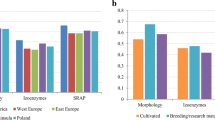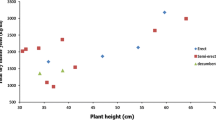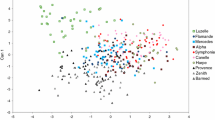Abstract
Alfalfa (Medicago sativa L.) is a forage legume of great interest because of its role in milk production schemes. Although it has the potential to be cultivated in different edaphoclimatic regions, the fodder production in tropical regions is limited. The objectives of this study were to perform phenotypic and molecular characterization of alfalfa germplasm, to examine the relationship between dissimilarity based on phenotypic and molecular information and to identify the germplasm with potential to generate base populations adapted to tropical conditions. The genetic values of nine traits from seventy-seven alfalfa accessions of a genetic background amenable to a temperate climate were obtained to characterize phenotypic diversity, and microsatellite markers were used to assess molecular diversity. Phenotypic information based on joint deviance analysis revealed the presence of genetic diversity. The correlation between the dissimilarity matrices of genetic values and molecular data was low. Based on phenotypic and molecular data, a great base population would be composed of Pro INTA Patricia, Pro INTA Super Monarca, Mecha, Magna 601, WL 525, ACA 900, Bacana, CUF 101, Crioula, and Ruano. These populations have at least 50 distinct parents, presented high dry matter yield, besides favorable alleles for regrowth ability, biomass yield, and persistence. The genetic variability observed for most traits indicates a high potential for the development of alfalfa base populations adapted to the tropical condition. Once adapted synthetic alfalfa populations are selected, they may be integrated into breeding programs in other tropical regions of the world.




Similar content being viewed by others
Availability of data and material
Not applicable.
Code availability
Not applicable.
References
Annicchiarico P, Carelli M (2014) Origin of ladino white clover as inferred from patterns of molecular and morphophysiological diversity. Crop Sci 54:2696–2706. https://doi.org/10.2135/cropsci2014.04.0308
Annicchiarico P, Barrett B, Brummer EC, Julier B, Marshall AH (2015) Achievements and challenges in improving temperate perennial forage legumes. Crit Rev Plant Sci 34:327–380. https://doi.org/10.1080/07352689.2014.898462
Annicchiarico P, Nazzicari N, Ananta A, Carelli M, Wei Y, Brummer EC (2016) Assessment of cultivar distinctness in alfalfa: a comparison of genotyping-by-sequencing, simple-sequence repeat marker, and morphophysiological observations. Plant Genome 9:1–12. https://doi.org/10.3835/plantgenome2015.10.0105
Annicchiarico P, Wei Y, Brummer EC (2017) Genetic structure of putative heterotic populations of alfalfa. Plant Breed 136:671–678. https://doi.org/10.1111/pbr.12511
Azevedo ALS, Costa PP, Machado JC, Machado MA, Pereira AV, Lédo FJS (2012) Cross species amplifcation of Pennisetum glaucum microsatellite markers in Pennisetum purpureum and genetic diversity of napier grass accessions. Crop Sci 52:1776–1785. https://doi.org/10.2135/cropsci2011.09.0480
Biazzi E, Nazzicari N, Pecetti L, Brummer EC, Palmonari A, Tava A, Annicchiarico P (2017) Genome-wide association mapping and genomic selection for alfalfa (Medicago sativa) forage quality traits. PLoS ONE 12:e0169234. https://doi.org/10.1371/journal.pone.0169234
Comeron EA, Ferreira RP, Vilela D, Kuwahara FA, Tupy O (2015) Utilização da alfafa em pastejos para alimentação de vacas leiteiras. In: Ferreira RP, Vilela D, Comeron EA, Bernardi ACC, Karam D (eds) Cultivo e utilização da alfafa em pastejo para alimentação de vacas leiteiras. Embrapa, Brasilia, pp 13–16
Creste S, Tulmann Neto A, Figueira A (2001) Detection of single sequence repeat polymorphisms in denaturing polyacrilamide sequencing gels by silver staining. Plant Mol Biol Rep 19:299–306. https://doi.org/10.1007/BF02772828
Cruz CD (2013) GENES—a software package for analysis in experimental statistics and quantitative genetics. Acta Sci Agron 5:271–276
Cruz CD (2016) Genes Software—extended and integrated with the R, Matlab and Selegen. Acta Sci Agron 38:547–552. https://doi.org/10.4025/actasciagron.v38i3.32629
Cruz CD, Ferreira FM, Pessoni LA (2011) Biometria aplicada ao estudo da diversidade genética. Suprema, Visconde do Rio Branco
Diwan N, Bhagwat AA, Bauchan GB, Cregan PB (1997) Simple sequence repeat DNA markers in alfalfa and perennial and annual Medicago species. Genome 40:887–895. https://doi.org/10.1139/g97-115
Doyle JJ, Doyle JL (1987) A rapid DNA isolation procedure for small quantities of fresh leaf tissue. Phytochem Bull 19:11–15
Eujayl I, Sledge MK, Wang L, May GD, Chekhovskiy K, Zwonitzer JC, Mian MA (2003) Medicago truncatula EST-SSRs reveal cross-species genetic markers for Medicago spp. Theor Appl Genet 108:414–422. https://doi.org/10.1007/s00122-003-1450-6
Fernandes FD, Braga GJ, Ramos AKB, Jank L, Carvalho MA, Maciel GA, Karia CT, Fonseca CEL (2017) Repeatability, number of harvests, and phenotypic stability of dry matter yield and quality traits of Panicum maximum jacq. Acta Sci Agron 39:149–155. https://doi.org/10.4025/actascianimsci.v39i2.32915
Ferreira RP, Vilela D (2015) Potencial de utilização da alfafa. In: Ferreira RP, Vilela D, Comeron EA, Bernardi ACC, Karam D (eds) Cultivo e utilização da alfafa em pastejo para alimentação de vacas leiteiras. Embrapa, Brasilia, pp 13–16
Ferreira RP, Basigalup DH, Vasconcelos ES, Cruz CD, Pereira AV (2008) Genética quantitativa e métodos de melhoramento em alfafa. In: Ferreira RP, Rassini JB, Rodrigues AA, Freitas AR, Camargo AC, Mendonça FC (eds) Cultivo e utilização da alfafa nos trópicos. Embrapa, Brasilia, pp 171–205
Flajoulot S, Ronfort J, Baudoin P, Barre P, Huguet T, Huyghe C, Julier B (2005) Genetic diversity among alfalfa (Medicago sativa) cultivars coming from a breeding program, using SSR markers. Theor Appl Genet 111:1420–1429. https://doi.org/10.1007/s00122-005-0074-4
Goering HK, Van Soest PJ (1970) Forage fiber analysis (apparatus, reagents, procedures and some applications). Agriculture Handbook 379. US Government Printing Office
Grandon NG, Alarcón Y, Moreno MV, Arolfo V, Orodizzi A, Basigalup DH, Gieco JO, Bruno C (2013) Genetic diversity among alfalfa genotypes (Medicago sativa L.) of non-dormant cultivars using SSR markers and agronomic traits. Revista de la Facultad de Ciencias Agrarias 45:181–195
Herrmann D, Flajoulot S, Barre P, Huyghe C, Ronfort J, Julier B (2018) Comparison of morphological traits and molecular markers to analyse diversity and structure of alfalfa (Medicago sativa L.) cultivars. Genet Resour Crop Evol 65:527–540. https://doi.org/10.1007/s10722-017-0551-z
Instituto Nacional de Tecnología Agropecuaria (2001) Prointa Patricia. https://inta.gob.ar/variedades/prointa-patricia. Accessed 20 Dec 2019
Jones GB, Tracy BF (2017) Persistence and productivity of orchardgrass and orchardgrass/alfalfa mixtures as affected by cutting height. Grass Forage Sci 73:544–552. https://doi.org/10.1111/gfs.12309
Julier B, Flajoulot S, Barre PG, Cardinet G, Santoni S, Huguet T, Huyghe C (2003) Construction of two genetic linkage maps in cultivated tetraploid alfalfa (Medicago sativa) using microsatellite and AFLP markers. BMC Plant Biol 3:9. https://doi.org/10.1186/1471-2229-3-9
Julier B, Barre PG, Lambroni P, Delaunay S, Thomasset M, Lafaillette F, Gensollen V (2018) Use of GBS markers to distinguish among lucerne varieties, with comparison to morphological traits. Mol Breed 38:133. https://doi.org/10.1007/s11032-018-0891-1
Kohonen T (2014) MATLAB implementations and applications of the self-organizing map. Unigrafia Ou, Helsinki
Kopp MM (2011) Origem, evolução e domesticação da alfafa. In: Ferreira RP, Basigalup DH, Gieco JO (eds) Melhoramento Genético da Alfafa. Embrapa, São Carlos, pp 225–260
Li X, Wang X, Wei Y, Brummer EC (2011) Prevalence of segregation distortion in diploid alfalfa and its implications for genetics and breeding applications. Theor Appl Genet 123:667–679. https://doi.org/10.1007/s00122-011-1617-5
Mantel N (1967) The detection of disease clustering and a generalized regression approach. Can Res 27:209–220
Matlab (2010) Matlab Version 7.10.0. Natick, MA: The Math Works Inc
Ministério da Agricultura e Pecuária—MAPA (2019) Formulários para registro de cultivares. http://www.agricultura.gov.br/assuntos/insumos-agropecuarios/insumos-agricolas/sementes-e-mudas/registro-nacional-de-cultivares-2013-rnc-1/formularios-para-registro-de-cultivares. Accessed 20 Dec 2019
Nagl N, Taski-Ajdukovic K, Barac G, Baburski A, Seccareccia I, Milic D, Katic S (2011) Estimation of the genetic diversity in tetraploid alfalfa populations based on RAPD markers for breeding purposes. Int J Mol Sci 12:5449–5460. https://doi.org/10.3390/ijms12085449
Narasimhamoorthy B, Bouton JH, Olsen KM, Sledge MK (2007) Quantitative trait loci and candidate gene mapping of aluminum tolerance in diploid alfalfa. Theor Appl Genet 114:901–913. https://doi.org/10.1007/s00122-006-0488-7
Odorizzi A, Mamani EMC, Sipowicz P, Julier B, Gieco J, Basigalup D (2015) Effect of phenotypic recurrent selection on genetic diversity of non-dormant multifoliolate lucerne (Medicago sativa L.) populations. Crop Pasture Sci 66:1190. https://doi.org/10.1071/CP14280
Oliveira MS, Santos IG, Cruz CD (2020) Self-organizing maps: a powerful tool for capturing genetic diversity patterns of populations. Euphytica 216:49. https://doi.org/10.1007/s10681-020-2569-0
Qiang H, Chen Z, Zhang Z, Wang X, Gao H, Wang Z (2015) Molecular diversity and population structure of a worldwide collection of cultivated tetraploid alfalfa (Medicago sativa subsp. sativa L.) germplasm as revealed by microsatellite markers. PLoS ONE 10:e0124592. https://doi.org/10.1371/journal.pone.0124592
R Core Team (2017) The R project for statistical computing—R version 3.4.3. http://www.r-project.org
Rassini JB (2002) Manejo da água na irrigação da alfafa num latossolo vermelho-amarelo. Pesqui Agropecu Bras 37:503–507
Rassini JB, Ferreira RP, Rodrigues AA, Barioni Junior W, Moreira A, Machado R (2007) Qualidade da forragem de alfafa na região Sudeste do Brasil. Embrapa. https://ainfo.cnptia.embrapa.br/digital/bitstream/CPPSE/17079/1/PROCIJBR2007.00088.pdf. Accessed 20 Dec 2019
Resende MDV (2016) Software Selegen-REML/BLUP: a useful tool for plant breeding. Crop Breed Appl Biotech 16:330–339. https://doi.org/10.1590/1984-70332016v16n4a49
Robins JG, Luth D, Campbell A, Bauchan GR, He C, Viands DR, Hansen JL, Brummer C (2007a) Genetic mapping of biomass production in tetraploid alfalfa. Crop Sci 47:1–10. https://doi.org/10.2135/cropsci2005.11.0401
Robins JG, Bauchan GR, Brummer EC (2007b) Genetic mapping forage yield, plant height, and regrowth at multiple harvests in tetraploid alfalfa (Medicago sativa L.). Crop Sci 47:11–18. https://doi.org/10.2135/cropsci2006.07.0447
Robins JG, Hansen JL, Viands DR, Brummer EC (2008) Genetic mapping of persistence in tetraploid alfalfa. Crop Sci 48:1780–1786. https://doi.org/10.2135/cropsci2008.02.0101
Rocha JRASC, Machado JC, Carneiro PCS, Carneiro JC, Resende MDV, Lédo FJS, Carneiro JES (2016) Bioenergetic potential and genetic diversity of elephantgrass via morpho-agronomic and biomass quality traits. Ind Crops Prod 95:485–492. https://doi.org/10.1016/j.indcrop.2016.10.060
Santos IG, Cruz CD, Nascimento M, Rosado RDS, Ferreira RP (2018) Direct, indirect and simultaneous selection as strategies for alfalfa breeding on forage yield and nutritive value. Pesqui Agropecu Trop 48:178–189. https://doi.org/10.1590/1983-40632018v4851950
Santos IG, Carneiro VQ, Silva Junior AC, Cruz CD, Soares PC (2019) Self-organizing maps in the study of genetic diversity among irrigated rice genotypes. Acta Sci Agron 41:e39803. https://doi.org/10.4025/actasciagron.v41i1.39803
Silva MJ, Pastina MM, Souza VF, Schaffert RE, Carneiro PCS, Noda RW, Carneiro JES, Damasceno CMB, Parrella RAC (2017) Phenotypic and molecular characterization of sweet sorghum accessions for bioenergy production. PLoS ONE 12:e0183504. https://doi.org/10.1371/journal.pone.0183504
Singh D (1981) The relative importance of characters affecting genetic divergence. Indian J Genet Plant Breed 41:237–245
Sledge MK, Ray IM, Jiang G (2005) An expressed sequence tag SSR map of tetraploid alfalfa (Medicago sativa L.). Theor Appl Genet 111:980–992. https://doi.org/10.1007/s00122-005-0038-8
Soriano JM, Villegas D, Aranzana MJ, Del Moral LFG, Royo C (2016) Genetic structure of modern durum wheat cultivars and mediterranean landraces matches with their agronomic performance. PLoS ONE 11:e0160983. https://doi.org/10.1371/journal.pone.0160983
Van Soest PJ (1963) Use of detergents in the analysis of fibrous feed. II. A rapid method of the determination of fiber and lignin. J Assoc Off Agric Chem 46:829–835
Vasconcelos ES, Ferreira RP, Cruz CD, Moreira A, Rassini JB, Freitas AR (2010) Estimativas de ganho genético por diferentes critérios de seleção em genótipos de alfafa. Revista Ceres 57:205–210
Wilkins PW, Humphreys MO (2003) Progress in breeding perennial forage grasses for temperate agriculture. J Agric Sci 140:129–150. https://doi.org/10.1017/S0021859603003058
Acknowledgements
The authors would like to thank Ana Carolina Bueno for lab support, the National Council for Scientific and Technological Development (CNPq), and Embrapa Pecuária Sudeste for supporting this work.
Funding
This study was financed in part by the Coordenação de Aperfeiçoamento de Pessoal de Nível Superior—Brasil (CAPES)—Finance Code 001.
Author information
Authors and Affiliations
Corresponding author
Ethics declarations
Conflicts of interest
The authors declare that they have no conflict of interest.
Ethics approval
Not applicable.
Consent to participate
Not applicable.
Consent for publication
Not applicable.
Additional information
Publisher's Note
Springer Nature remains neutral with regard to jurisdictional claims in published maps and institutional affiliations.
Electronic supplementary material
Below is the link to the electronic supplementary material.
Rights and permissions
About this article
Cite this article
dos Santos, I.G., Rocha, J.d., Vigna, B.B. et al. Exploring the diversity of alfalfa within Brazil for tropical production. Euphytica 216, 72 (2020). https://doi.org/10.1007/s10681-020-02606-w
Received:
Accepted:
Published:
DOI: https://doi.org/10.1007/s10681-020-02606-w




